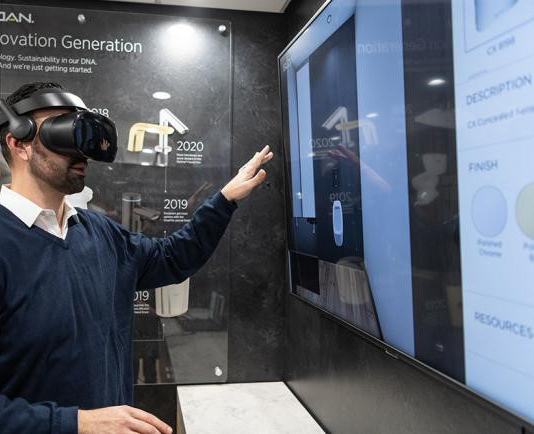The job requirements for architects and designers continue to evolve—as do the duties of the product manufacturers that work right alongside them. With over 30 years of experience in the commercial restroom, Jeff Gilmore has seen this evolution firsthand. As Sloan’s Director of Strategic Accounts, he works directly with the Architect and Design (A&D) community, showcasing everything that Sloan products have to offer across the entire restroom.
How has your job changed over the last 30 years?
The big changes have really been in the power and influence of the A&D community on the commercial restroom. Historically, the commercial restroom had largely been specified by a plumbing or mechanical engineer. But, in the last 10-15 years, that responsibility has shifted to the architect and interior designer, while the plumbing engineer now provides more oversight on the project’s mechanical design and functional as opposed to the restroom’s look and feel.
What do you think prompted this change?
Commercial restrooms have traditionally been provided out of necessity solely to satisfy building code requirements. Recently, there’s been a strong push towards making the commercial restroom another element of high design within a building. Outside of the lobby, the public restroom is probably the most visited space inside a building. Therefore, the restroom really has an opportunity to make an impression on a building’s occupants.
How has the digital era changed the way you’re able to communicate with the A&D community to help accommodate them?
Designers and architects are very visually-inspired people, so we’re tasked with showing the A&D community the latest and greatest. For them to be able to both see the product and understand the concept behind it as well as understand what it may mean for future projects really makes their jobs easier. For us, new innovations like virtual reality (VR) tools have been a huge asset in helping achieve these goals. We’re using VR to enable the designer to actually see the restroom layout from a 360-degree viewpoint with the ability to swap out faucets, soap dispensers, and fixtures, while changing the product finish and certain environmental design elements, as well. This provides architects and designers with a realistic indication of that restroom’s look and feel with each product and finish, a perspective they wouldn’t be able to get from a set of drawings.
With so many products now available on the market, how are Sloan’s product configurators helping specifiers to quickly and easily find the product they want?
There are so many options to select from in today’s specification process, with varying shapes, styles, finishes, and features across all restroom products. Tools like Sloan’s Flushometer Finder and Faucet Finder streamline the designer’s selection process, especially if they are in search of specific product information. Quickly this leads to their desired product based on their design criteria.
Sloan’s Mobile Showroom is currently on a nationwide tour displaying Sloan’s latest products and innovations. What spawned this idea?
As we continue to evolve—especially as a leader in technology and design partner—we wanted to create a way to deliver our message a little bit differently. Architects and designers are still very tactile people, so we wanted to be able to bring our product to their front door. In addition to material and finish displays, virtual reality (VR) experiences, product videos, and more, our mobile showroom allows users to look at, feel, and interact with our product, while having the ability to see and touch our custom finishes.
Technology has brought about so much change over the last several years. Where do you see things heading in the years to come?
It's going to be interesting to see where things go next. The commercial restroom continues to change, and it's gone from what used to be a very utilitarian- and function-driven space to something that requires a lot of design effort to create a space that makes an impression while still preserving the needed functionality.
I think we're still at the forefront of VR and how far that technology will help the design community. I certainly envision manufacturers providing more VR-related content in order to integrate the big picture across the entire building layout. Additionally, internet of things (IOT) and the idea of an interconnected restroom which allows your products to communicate in terms of diagnostics and maintenance will be something to watch for.
How will Sloan’s upcoming product collections continually work to make life easier for the A&D community?
Sloan’s collections series will consist of products designed together and intended for cohesive use in a singular restroom design. This will help to take some of the guesswork out of the interaction between the faucet and the lavatory or the faucet matching the soap dispenser and beyond. Ultimately, it will help to expedite the selection process.
This is the 11th edition in a series of Q&A segments with Sloan subject matter experts for their take on where the commercial restroom has been, what it’s evolved to now, and where it’s headed. A previous edition on the importance of parts can be found here.
Manténgase al Día
Regístrese para recibir notificaciones por correo electrónico y actualizaciones del blog de Sloan
